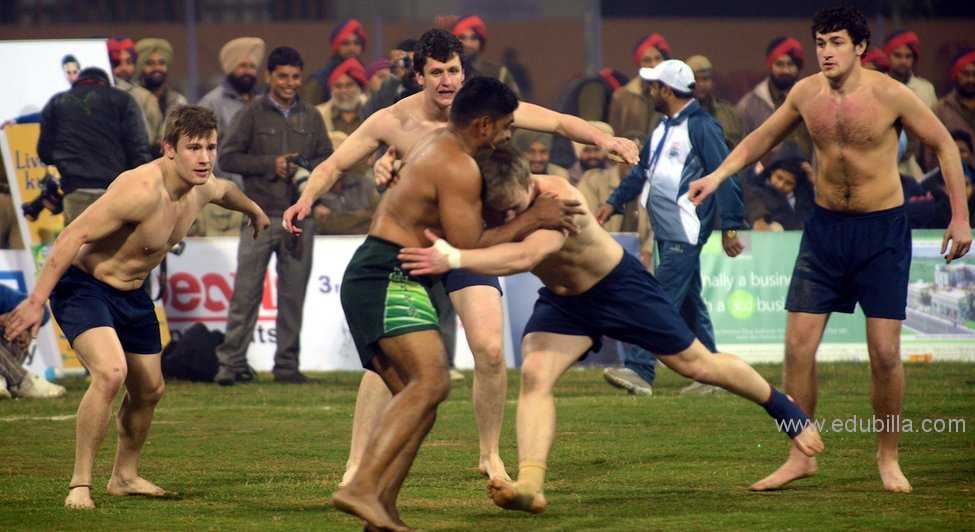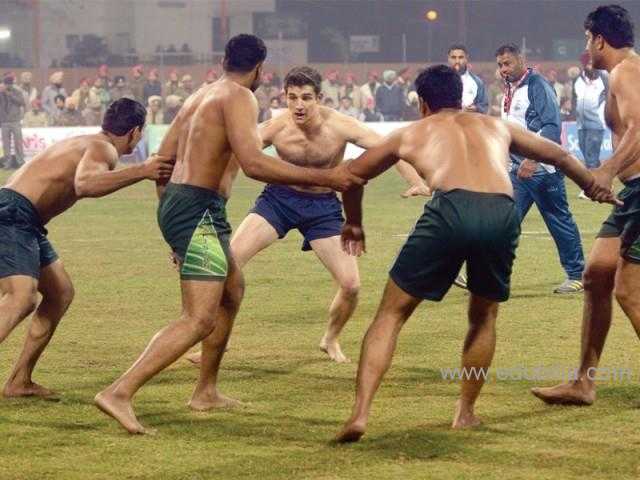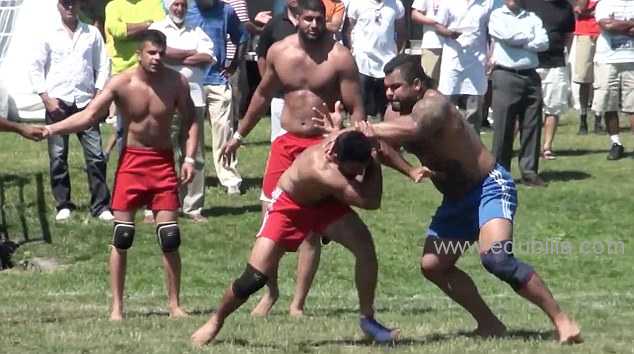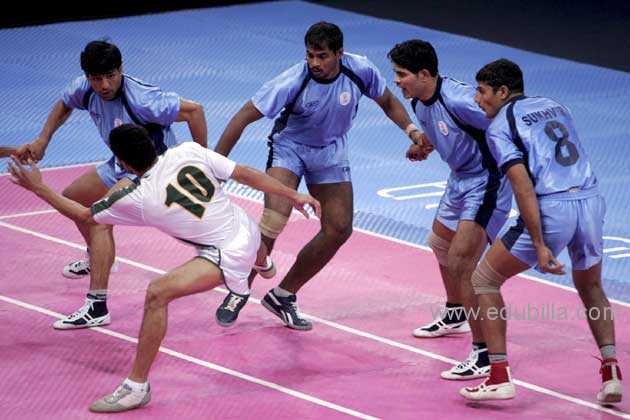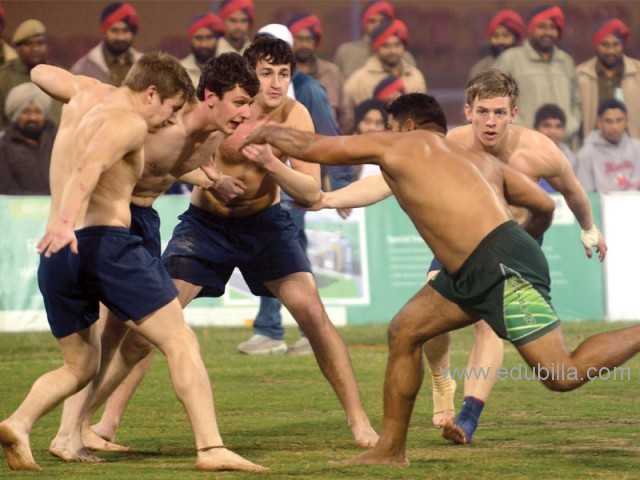
Overview Of International Kabaddi
Kabaddi (sometimes Kabbadi or Kabadi) is a contact sport that originated in Ancient India. The title Kabaddi is a generic term used to describe the following:
The forms of mainstream Kabaddi:
-International Kabaddi.
-National Kabaddi recognised by the Amateur Kabadi Federation of India:National style (which resembles the Sanjeevani style), Circle style (the Punjab style), Indoor and national games, Beach Kabaddi and National professional league Kabaddi.
-The three national styles recognised by the International Kabaddi Federation: Sanjeevani, Gaminee and Amar;
-Punjab Circle style governed by the Amateur Circle Kabaddi Federation of India and
-A number of similar contact sports which are peculiar to various regions such as hadudu in Bangladesh, baibalaa in Maldives, chedugudu in Andhra Pradesh, sadugudu in Tamil Nadu and Hututu in Maharashtra.
It is the national game of Bangladesh,and Nepal and also the state game of the Indian states of Tamil Nadu, Maharashtra, Bihar, Andhra Pradesh, Telangana and Punjab. India is the most successful team in the world stage having won every world cup and Asian Games titles so far.
Kabaddi initially became famous in Punjab Region as it was part of their per martial tradition, and is popular throughout South Asia, and has spread to Southeast Asia, Japan and Iran.
Game Rules
RULES OF THE GROUND:
1 - Ground
Ground shall be level, covered by standardized playing mat.
2 - Play Field Measurements
Men 13 X 10 Meters
MEN (Weight Limit) Below 85 Kg
3 - Play
Field The play field means that portion of the ground, which measures 13 meter by 8 meter
(ABCD) for Men before struggle.
4 - Sitting Block
The sitting block shall be as positioned and provided by the league.
5 - Boundary
The lines on the four sides of the play field are known as the boundaries (AB, BC, CD and DA). All lines shall be of 3 to 5 cm width and form the part of the play field.
6 - Lobbies
The strips on both the sides of the playfield measuring one meter in width are known as the Lobbies. When the lobbies, as per rule 4 under ‘Rules of Play’ are included in the playfield, the boundaries of the play-field are extended up to the four lines, which enclose the play-field including the lobbies.
7 - Mid Line
The line that divides the play field into two halves is known as the mid-line.
8 - Court
Each half of the play field divided by the mid line is known as the Court.
9 - Baulk Line
Each of the lines in court parallel to the midline is known as baulk line. The distance of the baulk line from the mid line shall be 3.75 meter in case of Men.
10 - Bonus Line
The line parallel to Baulk line towards end line is known as Bonus line. The distance between Bonus line and Baulk line shall be 1 meter.
Note: Raider is said to have crossed the Bonus line when he comes into contact with the ground between the End line and Bonus line. At the same time any part of his body should not have contact with the ground between the mid line and Bonus line.
11 - Cant
The repeated, without break; at a stretch and clear aloud sounding of the approved word “KABADDI” within the course of one respiration shall be called ‘Cant’.
12 - Raider
One who enters into the court of the opponent with the cant is known as a ‘RAIDER’. The raider must begin his cant before he touches the opponent’s court.
13 - Anti or Anti-Raider
Every player in whose court the raid is being made shall be called Anti or Anti Raider.
14 - Losing the cant
To stop the repeated and clear aloud sounding of the word KABADDI’ or take in a breath during cant by the raider is known as losing the cant. A cant must be continued within one and the same respiration.
15 - To put out an Anti
If a raider touches an anti without the breach of rules of play, or if any part of the body of an anti touches any part of the body of the raider, and then the raider touches his court with the cant, the anti is said to be put out.
16 - To hold a Raider
If the anti or antis hold the raider without breach of rules of play and keep the raider in their court and do not allow him to reach his court until he loses his cant or the Referee/Umpire blows the whistle, it is known as holding the raider.
17 - To reach court safely
If the raider touches his court with any part of the body through the midline without breach of rules with cant, he is said to have reached his court safely and turn of raid is over.
18 - Touch
If the raider touches the anti or antis by any part of his body or even the clothing / shoes, it is called a touch.
19 - Struggle
When the anti or antis come into contact with the raider, it is called struggle. After touch or struggle, the play field immediately includes the lobbies.
20 - Raid
a) When the raider enters the court of opponent with cant, it is known as Raid.
b) Each raid is restricted to 30 seconds (in both the halves) by the Stadium / TV clock (both Stadium / TV clocks to be synchronized with each other). The clocks will be set / reset as raider crosses the center line/when the raid is over. The clocks will be stopped when:
(i) Raider crosses center line on returning to his court
(ii) Raider exits the arena after being declared 'OUT', or goes out of bounds and is declared out.
21 - Completed Raid
When the raider crosses the Baulk line of the defending team at least once during the course of a raid and returns to his court with cant, it is known as a Completed Raid.
22 - Pursuit
When an anti rushes into the opponent’s court with cant, and without breach of rules, chasing the returning raider with a view to touch, it is called pursuit.
23 - Unproductive Raid
If a raider does not score any point or lose any point during the raid, the raid will be treated as unproductive raid of his team.
24 - Super catch
If the raider is caught when there are only 3 defenders or less, the defending team gets 1 additional point which is called Super Catch point. This is in addition to the normal point scored for putting the raider out (total points for defending team will be 2).
RULES OF PLAY:
01 - The team that wins the toss shall have the choice of the court, or the raid, and the team that loses the toss shall have the remaining choice. In the second half, the court shall be changed and the team, which did not opt for raid shall send their raider first. The game in the second half shall continue with the same number of players as it was at the end of the first half.
02 - A player shall be out if any part of his body touches the ground outside the boundary but during the struggle a player shall not be out if any part of his body touches the ground outside the boundary by keeping contact of the playfield.
The portion of contact must be inside the boundary.
03 - (a) If any player goes out of the boundary during the course of play, he shall be out. The Umpire or Referee shall try to take out such players at once. The Umpire or Referee shall declare such players out by calling out the numbers. No whistle shall be blown as the raid may continue.
(b) If an anti or antis who have gone out of bounds (as per rule 03), hold a raider, the raider shall be declared NOT OUT. Only the anti or antis who have gone out of bounds will be declared out.
04 - When the struggle begins, the play field includes the lobbies. During the struggle and after the struggle in the same raid, the players involved in the struggle can use the lobbies to enter their respective courts. This rule will only be applicable in the anti’s court.
05 - A raider shall continue to chant “KABADDI” as the approved cant. If he is not keeping the proper approved cant in the opponent’s court, he shall be ordered back and the opponent will be given one technical point and chance to raid. Under such circumstances, he shall not be pursued.
06 - A raider must start his cant before he touches the opponent’s court. If he starts the cant late, he shall be ordered back by the Umpire or Referee and the opponent will be given one technical point & a chance to raid.
07 - If a raider goes out of turn, the Umpire or Referee shall order him to go back and a technical point will be given to opponent team.
08 - Not more than one raider shall enter the opponent’s court at a time, if more than one raider enters the opponent’s court at a time, the Umpire or Referee shall order all to go back to their court and a technical point will be awarded to the opponent and chance to raid.
09 - (a) After a raider has reached his court, the opponents shall send their raider within 5 seconds. Each side shall continue to send their raider until the end of the game in this fashion. In case the raider fails to start his raid within 5 seconds the team loses its chance to raid and the opponent team gets a technical point.
(b) When a struggle takes place in a raid, on completion of such raid rule 09 (a) will not be applicable. The next raid will start on the blow of the whistle of the referee after the player/s put out is /are seated in the Out Bench/Box.
10 - If a raider, who is caught by the anti or antis, escapes from their attempt to hold and reaches his court safely he shall not be pursued.
Note: But if a raider touches the anti or antis and reaches his court safely, he may be pursued.
11 - If a raider, while in the opponent’s court looses his cant,he shall be out.
12 - When a raider is held, the antis shall not try deliberately to stifle his cant by shutting his mouth, using violent tackling leading to injuries, any type of scissoring or use of any unfair means. If such incident happens, the Umpire or Referee shall declare the raider NOT OUT.
13 - No anti shall willfully push the raider out of the boundary by any part of his (Anti’s) body, nor shall any raider willfully push or pull an anti or antis out of the boundary. If the raider is pushed outside the boundary or the anti is pushed or pulled outside the boundary, the Umpire or Referee shall declare the raider or the anti, as the case may be, as NOT OUT, and the anti or the raider who pushes or pulls the opponents outside the boundary shall be declared out.
14 - During the course of raid none of the antis shall touch the raider’s court until completion of the raid. In case any anti or antis touches the raider’s court before completion of the raid they will be declared out and the opponent team will be given that many points.
15 - If an anti or antis who are out, having violated Rule No. 14, holds a raider or violates the said rule while holding or helping to hold the raider, the raider shall be declared NOT OUT and the anti or antis who touches the raider’s court shall be declared OUT.
16 - When a team manages to put out the entire opponent team and none of the opponents are entitled to be revived, then that team scores a LONA and two extra points for LONA shall be awarded in addition to the points scored by the team putting out all the players of the opponent. The play continues and all the players who are out shall enter in their court within Ten Seconds. Otherwise the referee or umpire shall award one technical point to the opponent. If the team fails to enter within one minute, the team shall be scratched from the match and the match shall be awarded to the opponent.
17 - If a raider is warned or in any way instructed by one of his own side, the Umpire or Referee shall award one technical point to the opponent.
18 - A raider or an anti is not to be held by any part of his body deliberately other than his limb or trunk. The one who violates the rule shall be declared OUT. If the raider is held deliberately other than his limb or trunk, the Umpire or Referee shall declare such raider NOT OUT.
Note: If a raider is caught by his clothes or hair the raider shall be declared NOT OUT and the anti or antis who have violated the Rule shall be declared OUT.
19 - When one or two players of a team are left during the game and the Captain of the team declares them out in order to bring in the full team, the opponent shall score as many points as the players that existed in the court at the time of declaration as well as Two Extra Points for LONA.
20 - A Player or players who are out shall be revived in the same order as they were out.
21 - If a raider does not score any point or lose any point during the raid, the raid will be treated as unproductive raid of his team. In case a team makes three such consecutive unproductive raids, the raider of the third unproductive raid shall be declared out and the opponent team shall be awarded a point and gets chance for revival.
22 - TV Referral System: Will be dependent on logistics of Broadcaster. Each team will be given 2 unsuccessful referrals per game during the Semi-Final, 3rd /4th place playoff & Final matches. (The number of referrals can be reduced or increased as per logistics and will be declared before each session of the league) Referrals can be called to challenge line decisions as well as touches / tags. Based on replays available for the incident, the TV umpire’s decision in this case will be final.
Detailed Football Rules Can Be Downloaded From Documents
Equipments Need For International Kabaddi
Basically a simple inexpensive game played out door on level soft ground or sand, and neither requires sophisticated equipment , nor any expensive equipment. Later from the 3rd Asian Kabaddi Championship in Colombo, Sri Lanka in April 2000, the International Kabaddi tournaments were introduced as an indoor games and played on Eva foam mat
Players Benches:
Players benches with 6 seats
Stopwatches:
Stopwatches with 8 memory used in athletics
Table stop & go clock:
Table stop & go clock which is used in Basketball
Marking Tapes for the mats:
Marking tape 03 to 05 cms width in white colour to use on the mats for marking
Electronic Weighing Scales:
4 digits Electronic Scale to measure the Weight of the players
Whistles:
Whistles for officiating
Clip Pads (Writing):
For the use of scorer/Assistant Scorer
Referee Shoulder Bands,Umpire Shoulder Bands,Scorer Shoulder Bands,Asst. Scorer Shoulder Bands:
For Officiating
Table Score Board (Manual score board used in TT):
For emergency
Electronic Score Board:
The newer versions are played on synthetic mats and chants of kabaddi have been replaced by a 30-second time limit for each raid. The players also wear shirts - providing space for sponsors' logos, naturally - while electronic scoreboards lend a contemporary look to venues.
History Of International Kabaddi
The ancient Indian epic poem Mahabharata, in its account of the legendary battles of Kurukshetra in present day Haryana, tells of a military operation a doomed raid by Arjuna’s son, Abhimanyu, on an enemy camp—that has been noted for its resemblance to Kabaddi. For many years Kabaddi was played for physical exercise by pupils in Indian gurukuls (Vedic schools run by gurus). Though minor variations emerged, the game’s principal objective of raiding the enemy territory remained common. The variations however have manifested themselves into such games as Hututu, Sadugudu and many more.
Modern Kabaddi:
Accordingly, modern Kabaddi is a synthesis of the game played in various forms under different names.Kabaddi received international exposure during the 1936 Berlin Olympics, demonstrated by India. The game was introduced in the Indian National Games at Calcutta in 1938. In 1950 the All India Kabaddi Federation (AIKF) came into existence and framed the rules. The AIKF was reconstituted as The Amateur Kabaddi Federation of India (AKFI)in 1973 and the first nationals for men were held in Chennai.
Kabaddi was introduced and popularized in Japan in 1979 by Sundar Ram of India, who toured Japan on behalf of Asian Amateur Kabaddi Federation for two months to introduce the game. In 1979 matches between Bangladesh and India was held across India. The first Asian Kabaddi Championship was held in 1980 and India emerged as champion beating Bangladesh. The other teams in the tournament were Nepal, Malaysia, and Japan. The game was included for the first time in the Asian Games in Beijing in 1990 where seven teams took part. India won the gold medal and has also won gold at the subsequent seven Asian Games in Hiroshima in 1994, Bangkok in 1998, Busan in 2002, Doha in 2006, Guangzhou in 2010, and Incheon in 2014.
Origin Of International Kabaddi
First Kabaddi Game
First Kabaddi Championship:
The first Asian Kabaddi Championship was held in 1980 and India emerged as champion beating Bangladesh. The other teams in the tournament were Nepal, Malaysia, and Japan. The game was included for the first time in the Asian Games in Beijing in 1990 where seven teams took part. India won the gold medal and has also won gold at the subsequent seven Asian Games in Hiroshima in 1994, Bangkok in 1998, Busan in 2002, Doha in 2006, Guangzhou in 2010, and Incheon in 2014.
First Kabaddi World Cup:
The Kabaddi World Cup was first played in 2004 and then in 2007 and 2010. So far India is the unbeaten champion in Kabaddi World Cup. Pakistan and Iran are the next most successful nations, with the former being runners-up thrice and the latter twice. Note that Pakistan did not play the first two editions of the Kabaddi World-Cup (2004 and 2007) due to political tensions with the host nation India.
Governing Bodies
World Kabaddi Federation[WKF]:
The first ever International Federation for Kabaddi sport "World Kabaddi Federation" (WKF) was officially founded in 2003 with a vision to find a way to unite all the Kabaddi organizations as well as to use Kabaddi sport to promote peace, Harmony, understanding and Co-operation amongst the world community. later as per the decision of the First World Congress held on the 4th Nov. 2004, "World Kabaddi Federation" was incorporated under section 25 of the companies Act, 1956 on 30 the September 2005 with the Ministry of Corporate Affairs, Government of India as an International Sports Federation to govern the game of Kabaddi at international level in capacity of sole organisation in charge of all forms of Kabaddi sports in World; the representative authority in all other world bodies responsible for Commonwealth, Continental games, world games, regional and International Olympic games and other sports related global activities and programs.
It shall protect the game of Kabaddi from introduction of improper methods and practices by National and regional bodies which may bring the game into disrepute and It shall act as arbitrator in settlement of disputes of member countries and affiliates arising out of membership disputes and others. It shall organize and sanction International competitions, official World Cup, World Championships and all other Regional and International tournaments.
To Visit WFK Click Here
International Kabaddi Federation[IKF]:
The International Kabaddi Federation is the international governing body of Kabaddi. Its membership comprises 31 national associations.The federation was formed in 2004. The founder president is being Janardan Singh Gehlot from India. The other office bearers were: Mohammed Ali Pour (Iran), Khana Jawa (Japan), Veerawat (Thailand), Yoon Yeong Hak (South Korea), Ashok Das (United Kingdom); (Vice-president), Nisar Ahmed (Germany); (Secretary), R.M. Sunderashan (Malaysia); (Treasurer), Jaya Shetty (India); (CEO), Shankarrao Salvi (India); (Adviser)
Awards Related To International Kabaddi
Arjuna Award:
The Arjuna Awards are given by the Ministry of Youth Affairs and Sports, government of India to recognize outstanding achievement in National sports. Instituted in 1961, the award carries a cash prize of INR 500,000, a bronze statuette of Arjuna and a scroll.
Over the years the scope of the award has been expanded and a large number of sports persons who belonged to the pre-Arjun Award era were also included in the list. Further, the number of disciplines for which the award is given was increased to include indigenous games and the physically handicapped category.
The Government has recently revised the scheme for the Arjun Award. As per the revised guidelines, to be eligible for the Award, a sportsperson should not only have had good performance consistently for the previous three years at the international level with excellence for the year for which the Award is recommended, but should also have shown qualities of leadership, sportsmanship and a sense of discipline.
Winner-List-Arjun-Award-Kabaddi:
1972 -Shri S. M. Shetty
1973 -Shri Bholanath Guin
1978-79 -Km. S. P. Khatavkar
1980-81 -Shri Shantaram Jadhav
1981 -Km. Monika Nath
1983-Km. Maya Kashinath
1986-Km. Rama Sarkar
1990-Shri Hardeep Singh
1994-Shri Ashok D. Shinde
1994-Shri S. Rajrathanam
1995-Shri P. Ganeshan
1996-Ms. Neeta Moreshwar Dadwe
1996-Shri Shriram Bhavsar
1997-Shri Randhir Singh
1998-Shri Ashan Kumar
1998-Shri Biswajit Palit
1999-Shri Balwinder Singh
1999-Shri Tirath Raj
2000-Shri C. Homonappa
2001-Shri B. C. Ramesh
2002-Shri Ram Mehar Singh
2003-Sh. Sanjeev Kumar
2004-Sunder Singh
2005-Shri Ramesh Kumar
2006-Shri Navneet Gautum
2009-Shri Pankaj Navanath Shirsat
Padma Shri:
Padma Shri (also Padmashree) is the fourth highest civilian award in the Republic of India, after the Bharat Ratna, the Padma Vibhushan and the Padma Bhushan. It is awarded by the Government of India. The award is announced every year on Republic Day
Dronacharya Award:
Dronacharya Award is an award presented by the Ministry of Youth Affairs and Sports, government of India for excellence in sports coaching.The award comprises a bronze statuette of Dronacharya, a scroll of honour and a cash component of Rs.300,000. The award was instituted in 1985.
As the best sportsperson award is named Arjuna Award, it is appropriate that the coaching award is named after Dronacharya, as he was the teacher of Arjuna. B.I. Fernandez is the first foreign coach to be awarded Dronacharya Award
Dronacharya Award kabaddi Recipients:
2002-E. Prasad Rao
2005-Balwan Singh
2009-J. Uday Kumar
2012-Sunil Dabas
Dhyan Chand Award:
Dhyan Chand Award is India's highest award for lifetime achievement in sports and games, given by the Ministry of Youth Affairs and Sports, Government of India.The award is named after the legendary Indian hockey player Dhyan Chand. The award was initiated in 2002.The award carries a cash prize of INR 500,000, a plaque and a scroll of honour.
In August 2013, 4 individuals were awarded the Dhyan Chand Award: Syed Ali (Hockey), Mary D'Souza (Sequeira) (Athletics), Anil Maan (Wrestling) and Giriraj Singh (Para-Sports)
Dhyan Chand Award kabaddi Recipients:
2007-Shamsher Singh
Sample Documents Of International Kabaddi
-Sachin Tendulkar

